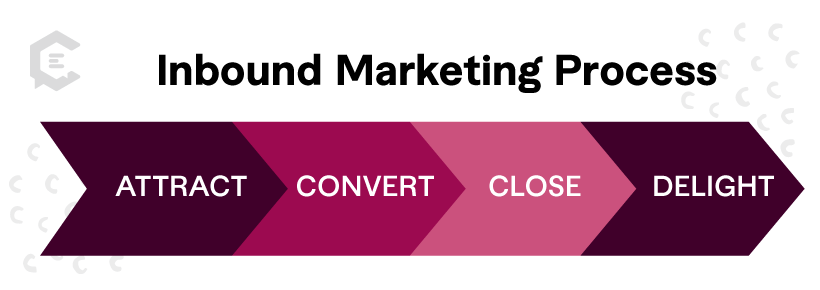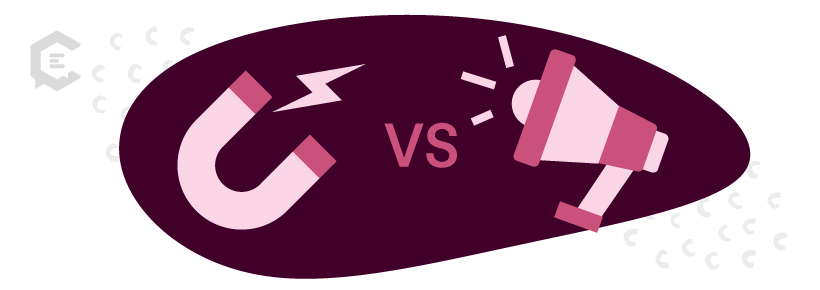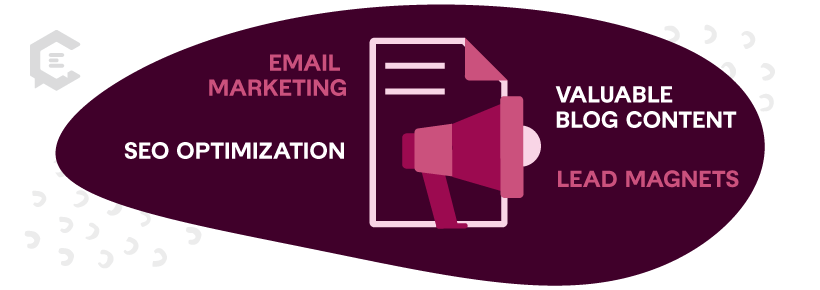What is inbound marketing?
Inbound marketing is a customer-centric strategy that attracts potential customers through valuable content and experiences. Traditional outbound marketing involves reaching a broad audience through advertising, cold calling, or direct mail. Inbound marketing aims to pull in customers organically by providing them with relevant and helpful information.
The inbound marketing methodology follows a four-stage process:
- Attract: Attract the right audience to your website by creating valuable content that addresses their needs and interests.
- Convert: Convert visitors into leads by offering them something of value in exchange for their contact information. A few good examples are ebooks, webinar registration, or newsletter signups.
- Close: Turn leads into customers by nurturing them through the sales process with targeted and personalized communication.
- Delight: Delight customers after the sale to build loyalty and turn them into brand advocates who refer others to your business.
Why is inbound marketing so important?
We live in a world driven by self-service, self-management, and self-education. Inbound marketing is a way to fulfill the modern buyer’s quest for knowledge with less in-your-face interactions from your brand.
Inbound Marketing uses a “pull technique” focused on connecting with customers on their terms. Reaching a customer “on their terms” means the person was already looking for this information or potential solution. And that engagement encourages actions that lead to conversions
Because inbound marketing attracts leads who are genuinely interested in your products or services, they’re more likely to convert into customers. It is a long-term strategy that continues attracting visitors over time. Once established, your inbound infrastructure can drive organic traffic to your business for years.
Inbound marketing vs. outbound marketing
The most successful brands strike a balance between inbound marketing and outbound marketing strategies to generate leads. Both systems work in tandem to drive interest and conversions.
Inbound marketing uses modern tactics, such as blogs or videos distributed by email or social media, to draw people in. Whereas outbound marketing uses traditional tactics, such as direct mail and ads, to push people to your service.
Sometimes outbound gets a bad rap for being “too pushy.” However, outbound is not the bad guy. Instead of competing, both strategies and teams should work together to achieve results.
Common types of inbound marketing
- Website
- Landing page
- Form
- CTA (call-to-action)
- SEO (search engine optimization)
- SEM (search engine marketing)
- Opt-in email marketing
- Social media
- Blogs
- Articles
- Webinars
- Guides
- Reports
- FAQs
- Testimonials
- Case studies
- Et al. — Here are more content types.
Common types of outbound marketing:
- Ads — Social media, TV, radio, websites, PPC (pay-per-click)
- Direct mail
- Cold outreach — Calls or emails
- Telemarketing
- Marketing automation
- Email marketing
- Press releases
- Retargeting
- Trade shows
- Content syndication
Inbound marketing vs. content marketing
Content marketing has become synonymous with inbound marketing, even though it is a strategy within a strategy. At this point, it’s safe to say that content marketing has a proven track record as an effective inbound strategy.
Depending on who you ask, one person will say content marketing is a critical piece of inbound marketing. Another will say inbound marketing is an essential piece of content marketing.
Whatever your viewpoint is, one thing is certain: inbound doesn’t work without content, and content doesn’t work without inbound. I like to think of it this way – inbound is being in the driving seat and content is the vehicle.
Inbound marketing examples to fuel your strategy
Since inbound marketing is multifaceted, you have multiple drivers steering people’s attention toward a single piece of content. Those different facets work together to build awareness, trust, and leads.
Let’s imagine we’re building a marketing strategy for a software company that offers a project management tool for businesses. Here’s how we might implement inbound marketing to attract, engage, and convert potential customers:
Valuable Blog Content:
The software company maintains a blog that regularly publishes articles on project management best practices, productivity tips, and industry trends. The blog content is informative, practical, and designed to address project managers’ pain points.
SEO Optimization:
They begin to use search engine optimization techniques to ensure their blog posts rank high in search engine results for relevant keywords. As a result, when users search for project management solutions, they’ll likely come across the company’s blog posts.
Lead Magnets:
To capture leads, the company starts offering downloadable resources such as comprehensive guides on project planning, templates for project documentation, and eBooks on effective team collaboration. Users can then access these resources in exchange for providing their email addresses.
Email Marketing:
The company nurtures users through automated email campaigns once users opt in and become leads. The emails provide additional valuable content, share success stories of other businesses using their software, and offer exclusive deals or free trials to encourage conversion.
By implementing this inbound marketing strategy, the software company:
- Attracts a steady stream of qualified leads
- Builds brand authority
- Nurtures potential customers, resulting in increased conversions
Inbound Marketing Next Steps
If we distill inbound marketing down to a single word, it’s “invitation”. You don’t want to assume someone knows an event that they wish to attend is going on. People are busy, distracted, and still want to be invited to the party.
We know how crowded the digital environment is, but we also know how inbound marketing can help you stand out Be the brand that creates great content and invites people to enjoy it by speaking to a ClearVoice content specialist today!






